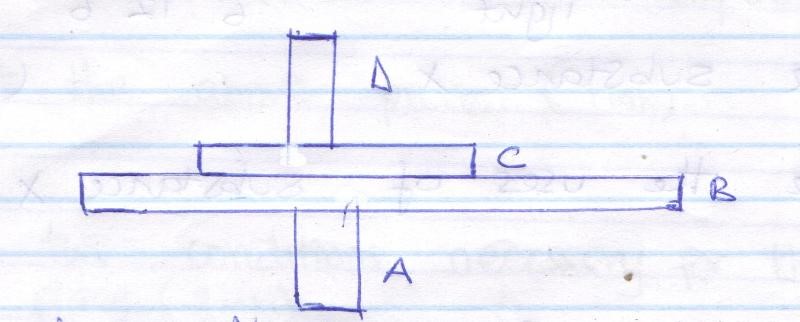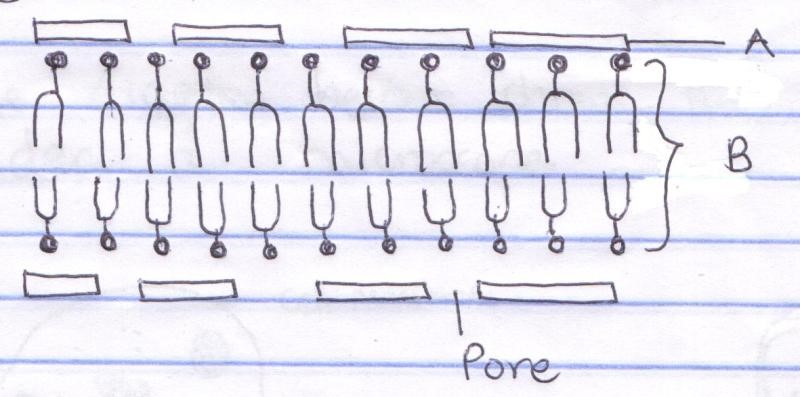- Define the following terms:
- Microbiology (1 mark)
- Zoology (1 mark)
- Give three characteristics of kingdom fungi. (3 marks)
-
- Why is Lamarck theory discredited by modern Genetics? (1 mark)
- Name two theories that explain the origin of a man. (2 marks)
- What is organic evolution? (1 mark)
-
- Define what capsarian strip is. (1 mark)
- State 3 factors affecting mineral salt absorption in plants. (3 marks)
-
- Distinguish between open circulatory system and closed circulatory system. (2 marks)
- Give two types of double circulation. (2 marks)
-
- State two differences between a light microscope and an election microscope with respect to details in the specimen observed. (2 marks)
- When observed under a microscope two type of cells in maintain blood appears as shown below:

- Identify each cell and give a reason for your answer. (2 marks)
A……………………………………..
B……………………………………….. - Which of two cells is more abundant in a blood smear? (1 mark)
- Identify each cell and give a reason for your answer. (2 marks)
- The set up below shows an experiment carried out by Form three students. Study it and answer the question below.

- Predict what changes would be observed after 15 minutes. (2 marks)
- Explain the possible causes of your prediction in (a) above. (4 marks)
-
- State two theories that explain the opening and closing of stomata. (2 marks)
- What is the effect of accumulation of Carbon IV Oxide in plant leaves? (3 marks)
- State three characteristics of respiratory surfaces in animals. (3 marks)
-
- Name the excretory structures and organs in the following organisms
- Amoeba
- Cockroach
- What is the Biological significance of having a long loop of henle in an organism? (1 mark)
- Name the excretory structures and organs in the following organisms
-
- State three uses of excretory products from plants. (3 marks)
- What are uricotelic organisms. (1 mark)
- The diagram below shows an inverted pyramid of numbers of organisms A,B,C and D

Identify the organism with the:-- Highest population (1 mark)
- Highest biomass. (1 marks)
- State the relationship between
- A bacteria and a root nodule of a legume. (1 mark)
- plant leaf and a phytophthora infectious fungi. (1 mark)
- A lion and wild beast in a savannah grassland. (1 mark)
-
- State the site of photolysis in a plant cell. (1 mark)
- State the role played by light energy during photolysis. (2 marks)
- Study the process below then answer the questions that follow:

- Name substance X. (1 mark)
- State the uses of substance X in animals. (2 marks)
-
- Name the forms in which carbohydrates are stored in:-
- Plant cells. (1 mark)
- Animal cells. (1 mark)
- Explain the advantages of storing food in an animal’s body in the form you have named in (a) above. (2 marks)
- Name the forms in which carbohydrates are stored in:-
- The equation below represents a process that takes place in green plants.
Carbon(IV) oxide + water → carbohydrate + oxygen gas.- Name the above process. (1 mark)
- Give two conditions necessary for the process to take place. (2 marks)
- The diagram below represents part of a cell organelle

- Identify the cell organelle. (1 mark)
- Name the part labeled A and B. (2 marks)
- State the physiological mprocess that this structure facikitates. (3 marks)
- List three difference between aerobic and anaerobic respiration. (3 marks)
- The diagram below shows two cells as observed under a microscope.

- With reasons in each case identify cell A and B cell.
Cell A: (2 marks)
Cell B: (2 marks) - Name the parts labeled E, D and M. (3 marks)
- E.
- D
- M.
- State the functions of the parts labeled P and F. (2 marks)
- P.
- F.
- With reasons in each case identify cell A and B cell.
FORM THREE BIOLOGY MARKING SCHEME
- Microbiology – This is the study of micro- organism. (1 mark)
Zoology - The study of animals. (1 mark) -
- They are unicellular or multicellular. (1 mark)
- They are heterotrophic or saprophytic. (1 mark)
- Their walls are made of chitin not cellulose. (1mark)
-
- Acquired characters that do not affects the genotypes are never inherited as Lamark’s theory proposed. (1 mark)
- Special creation and chemical creation. (1 mark).
- Organic evolution is the gradual development of organism from pre-existing forms to move advanced firms over a relatively long period of time. (1 mark)
- Casparian strip -: It is a bundle like thickening in endodermis which controls permeability. (1 mark)
- Open circulatory system is the system where by the transport of the blood is through the body cavity (general body cavity called haemocoel, (1 mark)
while closed is the system where blood is transported through special tube called vessels or blood vessels. (1 mark). -
-
Light microscope.
Election microscope.
Low magnifying power.
High magnifying power.
Low resolving power.
High resolving power.
-
- A – Red blood cell = no nucleus.
B - White blood cell = nucleated.i. - A/Red blood cell.
- A – Red blood cell = no nucleus.
-
-
- The starch solution will charge to blue/ blue black/ purple.
The iodine solution will remain brown/faded brown. - Iodine molecules/ ions are small hence they diffuse across the semi permeable.
visking tubing into the starch solution leading to color change.
Starch molecules are large hence they cannot diffuse into the iodine solution
Hence no color changes in the visking tubing.
- The starch solution will charge to blue/ blue black/ purple.
-
- Photosynthetic theory.
- Starch sugar theory. - It lowers the pH, which forms the conversion of glucose to starch in the leaf.
- Large surface area for increase diffusion.
Thin and moist to dissolve gases before diffusion.
Vasculalised/ large supply of blood to carry away diffused gases.
- Photosynthetic theory.
-
- Amoeba – Cell membrane and contradile vacuole.
Cockroach – Malpigian tubules. - To increase surface area for reabsorption of water in order to consene it.
- Amoeba – Cell membrane and contradile vacuole.
-
- Gum - Chewing gum
Papaine - Meat tenderizer
Knat - Drug.
Latex - Rubber.
Taniunm - Lanning. - Organism that excrete nitrogenous waste inform of uric acid.
- Gum - Chewing gum
-
- B
- A (2 mark)
-
- Symbiosis.
- Parasitism.
- Predation. (3 marks)
-
- Granum/grana. (1 mark)
- Chlorophyll molecule absorbs light energy, and uses it to split up water molecules into hydrogen ions and oxygen. (2 marks)
-
- X is oxygen. (1 mark)
- It is used for the process of respiration to oxidize food substances thereby providing energy for life processes. (2 marks)
-
-
- Starch. (1mark)
- Glycogen. (1 mark)
- The above forms are usually inactive and can be stored without changing the osmotic pressure in the body fluids. (2 marks)
-
-
- Photosynthesis. (1 mark)
- Presence of light and Chlorophyll. (2 marks)
-
- Plasma membrane/ cell membrane. (1 mark)
- A- Protein layer. (1 mark)
B – Phospholipids’ layer. (1 mark) - Diffusion.
Osmosis.
Active transport. (3 marks)
Aerobic Respiration
Anaerobic Respiration.
- Oxygen is used.
- Substrate is completely broken down to CO2 and water.
- High amount of energy released.
- Water molecules produced.
- Take place in both cytoplasm.
- Oxygen is not used.
- Substrate is partially broken down.
- Low amount of energy released.
- Water molecules not produced.
- Take place in the cytoplasm only.
-
- Cell A: Animal cell. Reason; lack of cell wall, chloroplasts and a sap vacuole. (1 mark)
Cell B: Plant cell. Reason; presence of cell wall, chloroplasts and a sap vacuole. (1 mark) - D - Cell vacuole
E - Cell wall. (1 mark)
M - Cytoplasm. (2 marks) - P - Controls all the cell activities
F - Site for photosynthesis. (2 marks)
- Cell A: Animal cell. Reason; lack of cell wall, chloroplasts and a sap vacuole. (1 mark)
Download BIOLOGY - FORM 3 END TERM 1 EXAMS 2020.
Tap Here to Download for 50/-
Get on WhatsApp for 50/-
Why download?
- ✔ To read offline at any time.
- ✔ To Print at your convenience
- ✔ Share Easily with Friends / Students

